The brand new Trek Slash has big shoes to fill, its predecessor being one of the most popular 29er enduro bikes on the market. We were all the more excited to find out if the new bike can hold its own against the increasingly tough competition. Spoiler alert: yes, it can – we even awarded it the Best Buy. But it isn’t without its faults.
For an overview of the test fleet head to the group test: The best enduro bike 2021 – 13 models in review

Manufacturer’s website
We could go on forever about the brand new Trek Slash. The bike is full of smart details and special solutions, be it the storage compartment in the frame, which is also available on the aluminium models, or the Knock Block in the head tube, which stops the handlebars from damaging the beautiful frame. Or the proprietary RockShox thru-shaft shock which allows the damping piston rod to pass through the shock, which is claimed to make the rear end respond more sensitively and deliver more traction. The new Slash offers 170 mm travel up front in combination with 160 mm at the rear and, as you’d expect, rolls on 29″ wheels. Trek have also improved on many other details, giving the bike an extra-large downtube protector, a threaded BSA bottom bracket and integrating the Mino-Link flip chip more cleanly into the seat stay.
The components of the Trek Slash 9.8 XT – A great overall package with minor weaknesses
In times when bikes are becoming more and more expensive, it’s nice to see the € 5,848 Slash 9.8 XT bucking this trend. This reasonably priced package gives you excellent components on a frame bursting with smart features. This includes Shimano’s XT 12-speed drivetrain and reliable SLX brakes, whose performance is in no way inferior to the more expensive counterpart. There’s nothing wrong with the RockShox ZEB Select+ either and the in-house Bontrager Line dropper post provides 170 mm of travel. However, we found the 35 mm stem to be too short and the 820 mm handlebar to be far too wide. You should also budget to replace the puncture-prone Bontrager tires. However, since Trek bikes are sold through local bike shops, these components and the small rear brake rotor can be swapped out on site. Ideally, you will only be charged the difference – provided you’ve got a good dealer.
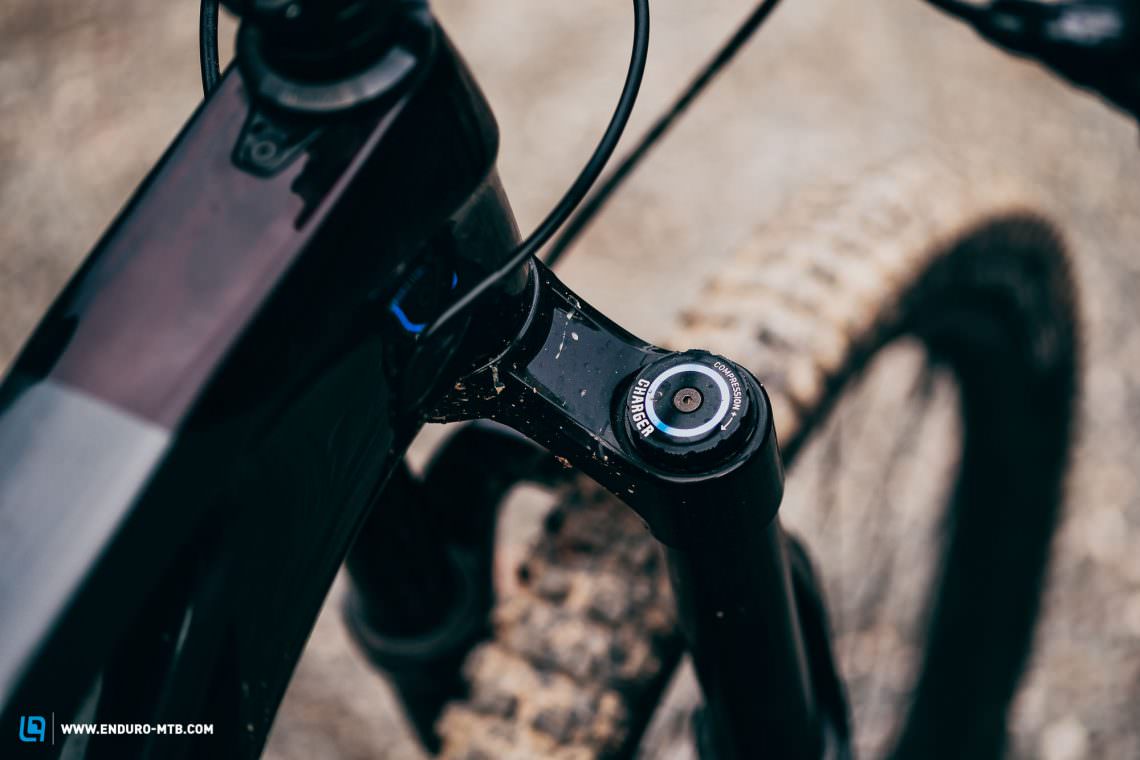

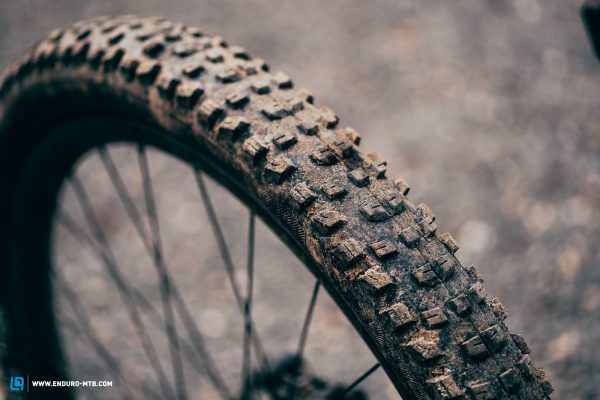
Trek Slash 9.8 XT
€ 5,848
Specifications
Fork RockShox ZEB Select+ 170 mm
Rear Shock RockShox Super Deluxe Ultimate 160 mm
Seatpost Bontrager Line Elite Dropper 170 mm
Brakes Shimano SLX 4-piston 200/180 mm
Drivetrain Shimano XT 30/10-51
Stem Bontrager Line Pro 35 mm
Handlebar Bontrager Line Pro OCLV Carbon 820 mm
Wheelset Bontrager Line Elite 30 OCLV Mountain Carbon
Tires Bontrager SE5 Team Issue/Bontrager SE4 Team Issue 2.6"/2.4"
Technical Data
Size S M ML L XL
Weight 14.84 kg
Wheelsize 29"

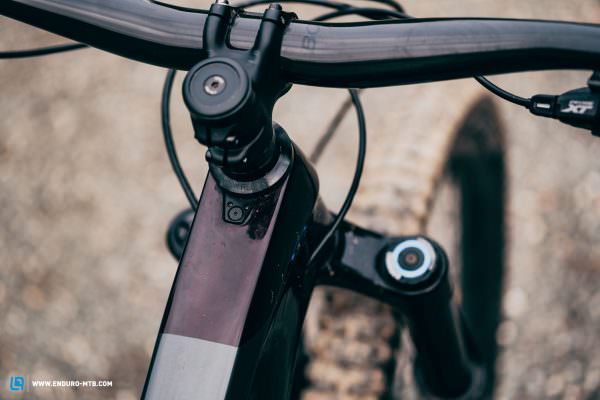

The geometry of the Trek Slash – An additional size for a hallelujah
A particular highlight of the Slash is that Trek have spared no expense and effort, adding an intermediate ML size to the range. This will be music to the ears of riders for whom the M is too small and L is often too big. It turned out to be the ideal size for our 180 cm tall test riders. The reach is 469 mm while chainstay length is a short 435 mm on all sizes. The head tube angle is 64.1° in the slack setting and the seat tube angle is 75.6°. This is significantly steeper than on the predecessor, though it’s still rather slack, and the kink in the seat tube makes it effectively slacker as the saddle is extended.
| Size | S | M | ML | L | XL |
|---|---|---|---|---|---|
| Seat tube | 395 mm | 420 mm | 435 mm | 450 mm | 500 mm |
| Top tube | 585 mm | 610 mm | 629 mm | 649 mm | 684 mm |
| Head tube | 100 mm | 100 mm | 105 mm | 115 mm | 140 mm |
| Head angle | 64.1° | 64.1° | 64.1° | 64.1° | 64.1° |
| Seat angle | 66.6° | 66.6° | 66.6° | 66.6° | 66.6° |
| Chainstays | 437 mm | 437 mm | 437 mm | 437 mm | 437 mm |
| BB Drop | 29 mm | 29 mm | 29 mm | 29 mm | 29 mm |
| Wheelbase | 1,197 mm | 1,222 mm | 1,243 mm | 1,264 mm | 1,305 mm |
| Reach | 425 mm | 450 mm | 469 mm | 486 mm | 516 mm |
| Stack | 621 mm | 622 mm | 626 mm | 635 mm | 658 mm |
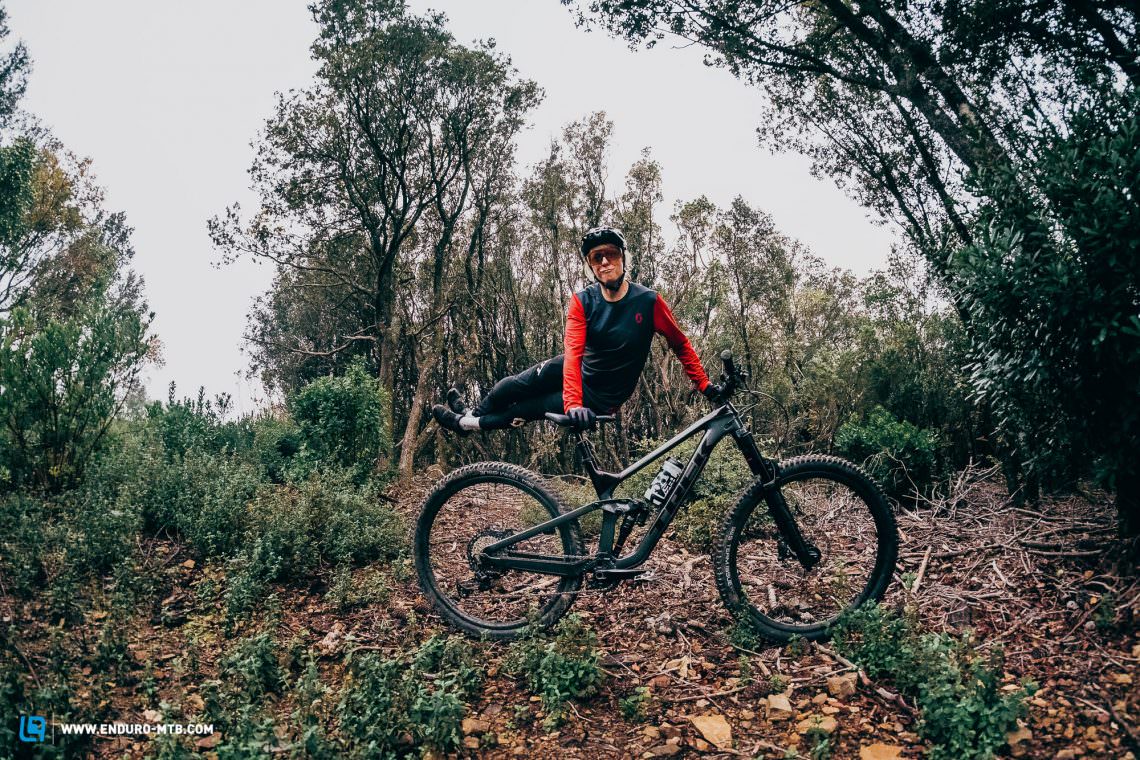
Trousers SCOTT Trail Contessa
Important tuning tip for the Slash – Push the saddle forward for the climbs!
As the geometry table suggests, the seat tube angle on the Slash is rather slack. In practice, this means that you should immediately slide the saddle forward so as not to sit too far over the rear wheel on steep climbs. With that done, the Slash climbs fairly efficiently. The suspension stays nice and firm, though as you pedal it still provides enough traction. You can spare yourself the effort of activating the climb switch – great!
While we found the new Slash to be unbalanced and cumbersome in our first review where we rode the size L, that impression changes with the smaller ML. Thanks to the shorter reach, your position on the bike is more central, distributing your weight evenly between the wheels and allowing for quicker, more precise direction changes.
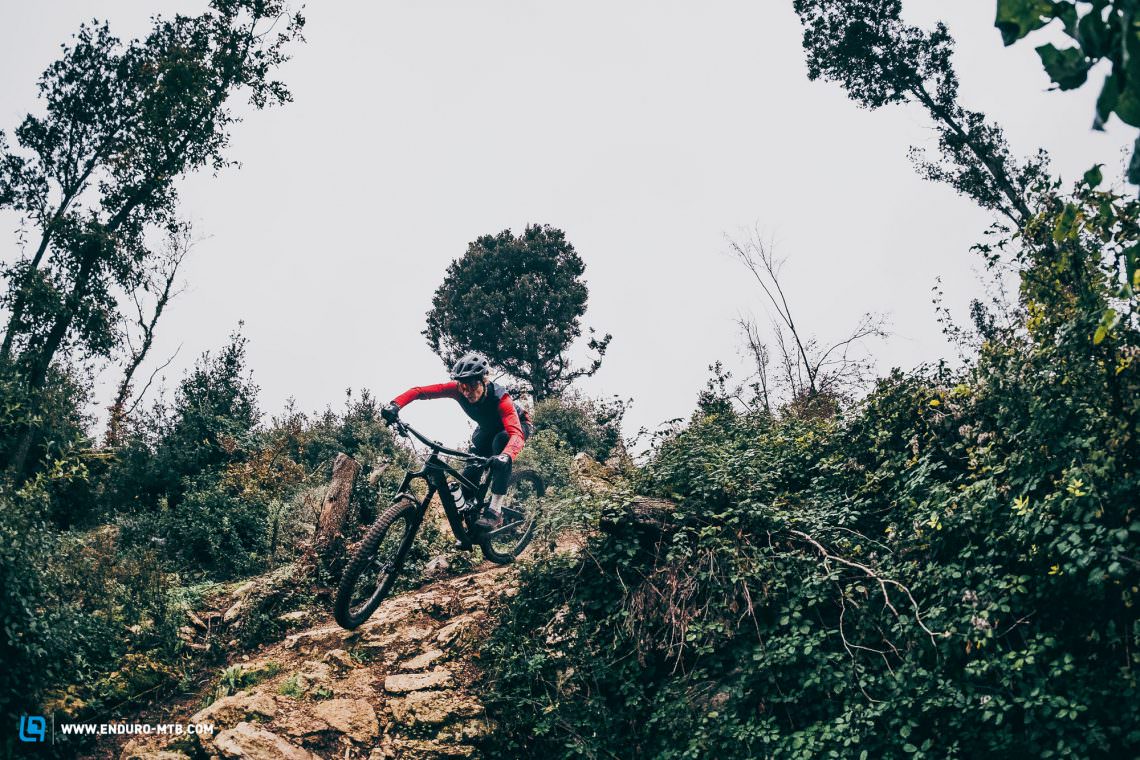
Fun, direct and capable – The Slash is a very versatile descender.
You can choose between three compression settings on the shock, which differ significantly. Even in the neutral position, the Slash offers a lot of support and begs you to pump it. Fast corners are an absolute pleasure and you can easily pull it up into a manual. Those who like to play with the trail will love this bike. The Slash also offers a lot of pop as you launch it off trail features, catching air with minimal effort. As a result, the Slash is amazingly fun even on simple trails! When things get more demanding, the Trek remains surprisingly composed and smooths out even the roughest terrain. However, it doesn’t isolate the rider from the ground and gives lots of feedback. The only thing slowing it down are the minor shortfalls in the components. Speaking of slowing down: we recommend upgrading the rear brake rotor to a 200 mm model if you predominantly ride steep trails.
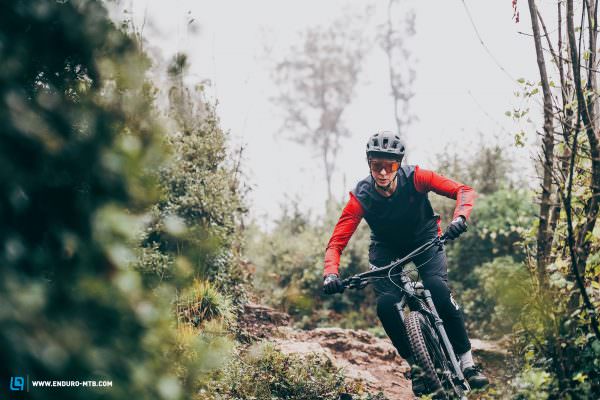
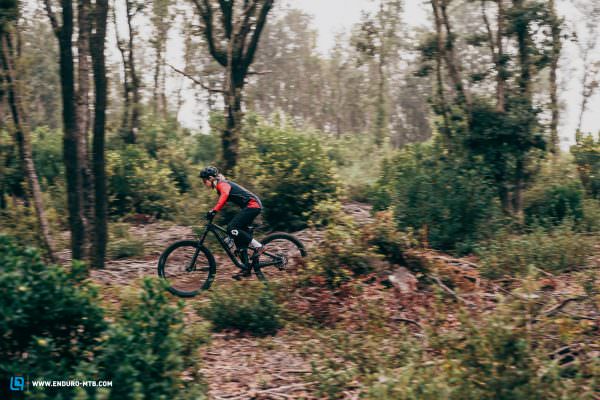
How does the Trek Slash 9.8 XT compare to the competition?
The Trek Slash and the Rocky Mountain Altitude are the champions of this test, but they couldn’t be more different. The Altitude is all about traction and speed, doing an incredible job of absorbing bumps. On the other hand, the Slash is more light-footed and playful. On the uphills, the more efficient Trek pulls away. If you want to ride hard, the Best in Test Altitude is the bike you need, but if you’re looking for the better all-rounder, you’ll be happy with the Slash, our Best Buy!
Tuning tips: if in doubt, downsize | bigger rotor at the rear | swap tires for grippier, more robust models | mount a longer stem and cut down the handlebar
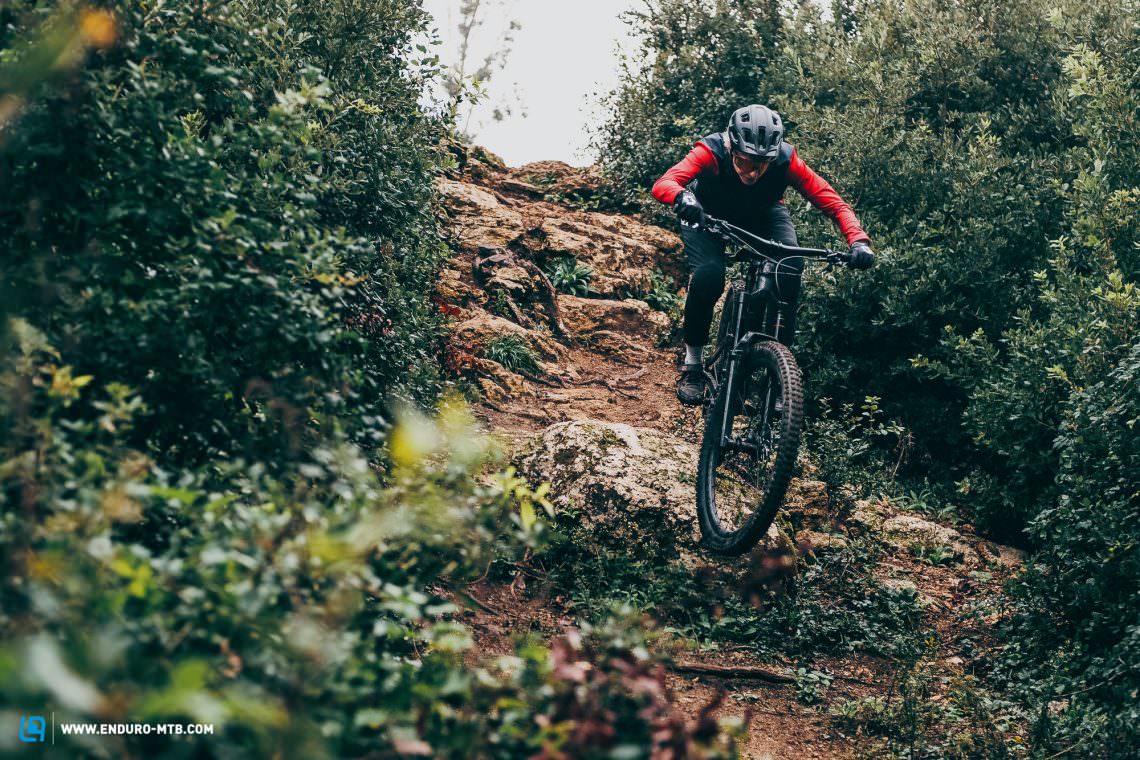
Conclusion
The brand new Trek Slash 9.8 XT succeeds in filling the shoes of its predecessor and, thanks to its enormous versatility, secures the coveted Best Buy! It’s agile, playful and direct enough to have loads of fun on flowing trails. At the same time, it doesn’t shy away from even the roughest terrain. The price for the beautiful carbon bike is reasonable, but you should budget for a few small upgrades.
Tops
- agile and balanced handling
- cleverly designed frame at a fair price
- versatile bike with a wide range of uses
Flops
- slack seat tube angle
- puncture-prone tires with moderate grip
- cockpit ergonomics

You can find out more about at trekbikes.com
The test field
For an overview of the test fleet head to the group test: The best enduro bike 2021 – 13 models in review
All bikes in test: Canyon Strive CFR (Click for review) | COMMENCAL Meta AM 29 Öhlins (Click for review) | GIANT Reign Advanced Pro 0 (Click for review) | Ibis Ripmo V2 (Click for review) | Nukeproof Mega 290 Alloy Pro (Click for review) | Propain Spindrift CF Mix Custom (Click for review) | Rocky Mountain Altitude Carbon 90 Rally Edition (Click for review) | Santa Cruz Megatower CC X01 Coil RSV (Click for review) | Santa Cruz Nomad CC X01 RSV (Click for review) | Specialized Enduro Expert (Click for review) | Specialized S-Works Stumpjumper EVO (Click for review) | Transition Sentinel XT (Click for review) | Trek Slash 9.8 XT

Did you enjoy this article? If so, we would be stoked if you decide to support us with a monthly contribution. By becoming a supporter of ENDURO, you will help secure a sustainable future for high-quality mountain bike journalism. Click here to learn more.
Words: Photos: Christoph Bayer, Valentin Rühl, Markus Frühmann









